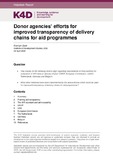| dc.contributor.author | Quak, Evert-jan | |
| dc.date.accessioned | 2020-04-21T10:00:37Z | |
| dc.date.available | 2020-04-21T10:00:37Z | |
| dc.date.issued | 2020-04-02 | |
| dc.identifier.citation | Quak, E. (2020). Donor agencies’ efforts for improved transparency of delivery chains for aid programmes. K4D Helpdesk Report No. 762. Brighton, UK: Institute of Development Studies. | en |
| dc.identifier.uri | https://opendocs.ids.ac.uk/opendocs/handle/20.500.12413/15235 | |
| dc.description.abstract | This rapid literature review academic sources, grey literature, and information and documents available on official organisation websites, on transparency and traceability of Official Development Assistance (ODA) within donor agencies’ development and humanitarian aid delivery chains. It draws heavily on grey literature and particularly on information on webpages. Academic research on aid transparency mainly measures the impact of transparency on aid effectiveness and focusses on measurements for aid transparency in general. Hence, sources describing what donor agencies precisely do to secure and improve transparency in delivery chains for aid programmes are mainly found on webpages of donor agencies and transparency initiatives. In general, the information on which this rapid review is based, shows that most donor agencies commit themselves to align aid transparency efforts according to the International Aid Transparency Initiative’s (IATI) common standard, which they have repeated in several other commitments over the last ten years. Donor agencies, development banks, special government-led development initiatives or programmes that publish aid data and information independently to IATI score very different on aid transparency, depending on the complexity of implementing the IATI standard within their organisational structures. Information on which this rapid review is based also shows that most donor agencies have initially prioritised their management of open source project and country data and overall aid spending by launching open data portals and dashboards. All donor agencies mentioned in this report (UNDP, US agencies, EC agencies, Netherlands MFA, German and Belgium agencies) have established such open data portals for their development projects. Most of these agencies are now in the process to include more disaggregated data (e.g. projects, budgets, subnational data) and get performance results and reviews (e.g. evaluation, monitoring, appraisals) in IATI formats. Hence, most of the mentioned donor organisations have low scores on the IATI performance indicators. | en |
| dc.language.iso | en | en |
| dc.publisher | IDS | en |
| dc.relation.ispartofseries | K4D Helpdesk Report;762 | |
| dc.rights.uri | https://www.nationalarchives.gov.uk/doc/open-government-licence/version/3/ | en |
| dc.subject | Aid | en |
| dc.subject | Development Policy | en |
| dc.subject | Governance | en |
| dc.title | Donor Agencies’ Efforts for Improved Transparency of Delivery Chains for Aid Programmes | en |
| dc.type | Helpdesk | en |
| dc.rights.holder | © DFID - Crown copyright 2020 | en |
| dcterms.dateAccepted | 2020-04-02 | |
| rioxxterms.funder | Department for International Development, UK Government | en |
| rioxxterms.identifier.project | K4D | en |
| rioxxterms.version | VoR | en |
| rioxxterms.funder.project | 238a9fa4-fe4a-4380-996b-995f33607ba0 | en |

